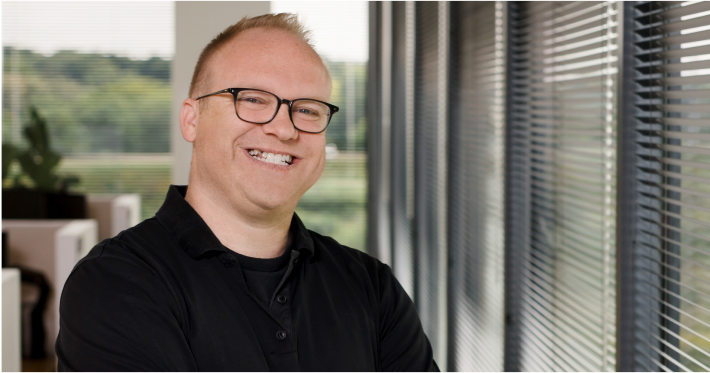When you try to give Mike Bishop credit for innovation, he’s quick to dismiss the notion that the best ideas are born from a sudden “lightbulb” or “Eureka!” moment. “It doesn’t work like that,” he says. “Innovation is almost always a thoughtful, collaborative process driven by a deep understanding of a very specific problem—and the strong desire to fix it.” That’s a customer-centric and team-focused point of view with day-to-day relevance because, as Managing Director with oversight of our product development, modeling, analytics, and InfoSec groups, Mike leads teams that invent and improve the leading-edge tools our clients find so indispensable.
It’s a role he came by in a reverse turn of events. As an actuary heading up an underwriting department at a pre-Affordable Care Act health insurer, he was an enthusiastic early adopter of our first identified data product. But when the ACA removed medical underwriting for individual health policies, Mike realized he had to fire IntelliScript.
Instead, we hired him. We had a groundbreaking invention up our sleeve (the first iteration of Curv® Group Health) and needed someone exactly like him to sell it. Having just been a client, he arrived with an acute sense of customer pain points. And as an actuary who previously ran an underwriting department, he understood how those two professions approach the same risks from fundamentally different perspectives.
That difference continues to shape the insurance industry’s adoption of new technology. Today, with even more advanced predictive models and other progressively sophisticated forms of AI in development, seeing all the “other sides”—including insurtech creators, insurers, third parties, and consumers—is more important than ever.
You describe yourself as an introvert. Did you have any trepidation about taking on what was initially a straight sales role?
If I’d been responsible for cold calls, we probably wouldn’t be talking right now! But I was an actuary-underwriter selling to other actuaries and underwriters. I was technical enough to answer their questions but relatable enough to present a complex predictive model in a manner they understood. And then as now, our approach was to demonstrate value with a study. Exaggerated claims and hard-sell tactics just aren’t our style; we’re more into quietly providing proof.
Of course, now I’m the product guy, but one of IntelliScript’s core qualities—something that makes us who we are—is the cross-functional way we approach every product or innovation. We capture synergies across an incredibly diverse talent pool ranging from clinicians to data scientists to relationship managers. Having that consumer mindset in-house definitely streamlines the process of choosing which projects to pursue and getting innovations into the market.
You’re an actuary but you’ve also been an underwriter. How do you reconcile their different ways of understanding risk?
An actuary can come up with a theoretical formula to set a rate; it may not be exactly right for any one client, but it will be right on average. But underwriters are closer to the customer. They have to explain why it’s the right rate. There are realities to navigate in those conversations and merits to both actuaries’ and underwriters’ arguments.
That helps me to empathize with clients who have actuaries and underwriters debating between a predictive risk score and a purely clinical interpretation. I understand why our life insurance clients are moving deliberately through this paradigm shift.
As an actuary, you’re already comfortable with sophisticated predictive models. Looking at that paradigm shift from an underwriter’s perspective, what will be required to accelerate acceptance?
We’ll continue to improve model efficiency, and that’s to say nothing of even more advanced AI that’s coming. Across the world, Milliman professionals are getting their arms around large language models like ChatGPT and other forms of generative AI. But in my view, equally important breakthroughs will come in transparency and explainability.
It is already clear that in many insurance use cases, predictive models make better decisions than traditional clinical underwriting. And in our experience, they can also increase access to insurance. But when I look at them from my old client or underwriter’s perspective—and speaking for the entire insurtech sector or even all of insurance—I realize we need to do a better job of helping others reach our level of confidence.
We’re taking steps to help customers understand our newest tools. For example, as we bring increasingly advanced models and more expansive production data sets to market, traditional underwriters see more and more profiles come back with favorable risk scores, even though they also have conditions that previously might have triggered an automatic decline.
It’s on us to explain that we’ve moved beyond merely automating legacy processes based on legacy insight into risks. We really do help customers see more. But the tricky part is helping them fear less because that expanded insight can be unnerving. Getting the maximum value from digital insight involves more than just adopting a digital process—it also means adopting a digital mindset. You have to understand and accept a lot of other perspectives.


